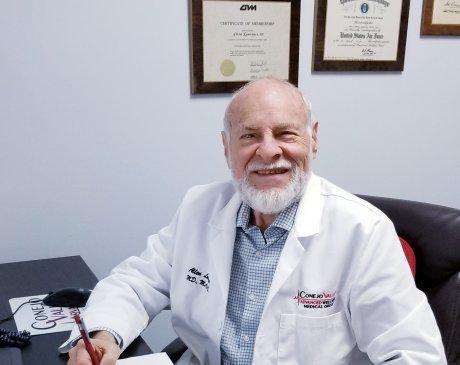- 21103 Vanowen St Woodland Hills, CA 91303 | Call us today!
- 310-879-9266
Values and Risks of Progesterone in Bioidentical Hormone Replacement Therapy (BHRT)

Years ago, in the ancient past of HRT when we knew much less bout the hormone components of HRT and BHRT was not yet used by most Gyn and medical practitioners’ progesterone was believed to have one and only one purpose.
It was thought that its only, or at least primary value, was in women who had a uterus and it was considered important for one and only one purpose to prevent Endometrial-Uterine Cancer.
Time has passed and now after some 70 years of using Female Replacement Hormone Therapy, we know differently. We now know that progesterone has multiple values as part of any HRT or BHRT regime.
One of the reasons progesterone was frowned upon is that it seemed that it have no value; if she was not going to become pregnant, it had no value. This came from the fact that progesterone is made by the woman’s body at the time of ovulation. It was released to support her becoming pregnant and maintaining her pregnancy. Obviously, it was reasoned, if pregnancy could no longer occur, the woman’s uterus had been removed and there was no longer any endometrium) then progesterone would no longer be needed. We now know that is a very shortsighted and incorrect observation.
The Many Values of Progesterone in BHRT
- Endometrial Protection: Progesterone is essential in HRT for women with an intact uterus to prevent endometrial hyperplasia and endometrial cancer, which can result from unopposed estrogen therapy.
- Menopause Symptom Relief: It helps alleviate menopausal symptoms such as hot flashes, night sweats, mood swings, and vaginal dryness.
- Bone Health: Progesterone, in combination with estrogen, contributes to the maintenance of bone density, reducing the risk of osteoporosis and fractures.
- Cardiovascular Benefits: Some studies suggest that progesterone may have a favorable effect on cardiovascular health when used in the correct formulations and dosages, though this is still an area of active research.
- Improved Sleep Quality: Progesterone acts to create relaxation ins women n BHRT. It promotes better sleep patterns and reduces risks, problems and symptoms associated with insomnia.
- Enhanced Mood Stability: Progesterone helps stabilize mood and reduces irritability.
- Support for Cognitive Function: Progesterone is recently been recognized and playing a role in aiding in maintaining cognitive clarity and function, increases and directs focus of attention and improves memory.
- Reduction in Anxiety and Depression Symptoms: Progesterone helps alleviate anxiety and depression associated with hormonal imbalance.
- Promotion of Hair and Skin Health: Contributes to healthier hair and skin.
- Increases Overall Quality of Life: Numerous recent studies have clearly indicated that BHRT increases overall quality of life in women (by their recognition) somewhere between 20% – 30%. Hence women on BHRT state that they have overall better lives after starting BHRT than before starting BHRT. Women on both bio-identical Estradiol and bio-identical Progesterone appear to rank higher than women on Estradiol alone.
Risks Associated with Progesterone
As with everything in life, what has value can also often have risk or problems associated with it. This is as true of progesterone as everything in the medical field.
- Breast Cancer: For years physician believed and research suggested that here is an increased risk of breast cancer with long-term use of combined estrogen-progestogen therapy, particularly with synthetic progestins (also known, interchangeably, as progestogen) rather than natural progesterone. For more than 50+ years American Ob/Gyns have used only progestogens (Provera) with Horse estrogen (Premarin) for treating symptoms of menopause. The recent Women’s Health Initiative (WHI) Study. When all of the data was locked at it was clearly the synthetic progestins (a synthetic version of progesterone, not at all natural to the female body) that caused the increase in breast cancers. Studies now suggest natural progesterone ( a totally different natural compound may lower the risk of breast cancer).
- Cardiovascular Events: An increased risk of heart disease, stroke, and blood clots has been associated with certain types of progestins (not progesterone) in HRT, especially in older women or those with pre-existing cardiovascular conditions.
- Mood Changes: Some women may experience mood swings, depression, or anxiety with progesterone (at excessive dosages) or with the use of any of the progestins.
- Other Side Effects: Common side effects can include bloating, breast tenderness, headaches, and irregular bleeding, which may affect adherence to therapy. Once gain these symptoms are more of a problem when women use synthetic progestins/progestogens.
While progesterone is a critical component of BHRT for its protective effects on the endometrium and its role in alleviating menopausal symptoms, it’s always must be used carefully weighing positive affects against potential negative risks, particularly concerning breast cancer and cardiovascular health. I do not believe that any woman should use any of the many synthetic progestins/progestogens for long-term treatment of menopause. Individualized treatment plans and ongoing monitoring are essential to optimize benefits and minimize adverse effects.

Article by Dr. Allen Lawrence, M.A., M.D., Ph.D.




